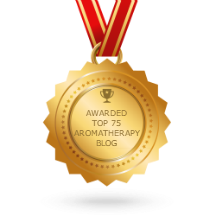Up until a few
years ago, one of the hallmarks of the coming Christmas season was the live
Rosemary "trees", potted, shaped and decorated like a Christmas
tree. It was the most wonderful
scent. Of course, when your kids are
young, you tend to be more frugal. For
years it was something that I never purchased, but would always stop to admire
and inhale while doing my shopping. As
hectic as those years were, that first year with no kids at home was rough, and
that year, I decided to indulge myself with one of those little
"trees". In the following
years, I have been unable to find those plants during the holidays. But for that one year, I had the most
up-lifting aroma in my home, when I needed it most.
Rosmarinus
officinalis is a perennial woody shrub with evergreen, needle-like leaves. The oil is extracted by steam
distillation. Rosemary essential oil is
unique in that it is one of the few oils that has multiple chemotypes. This means that the essential oils vary in
composition, yet are from the same species.
Different geographical locations are often associated with different
chemotypes. Rosemary oil from Spain,
known as CT1, has elevated camphor levels, whereas rosemary from Tunisia, CT2,
is higher in 1,8 -cineole. CT3 is
Rosemary from France, with elevated verbenone.
(1) Rosemarinus officinalis ch a- pinene has
higher levels of a-pinene., which allows for the fresh pine scent to come
across.
In the granite
hills country of Australia's Central Victoria, Chris Burder, owner of StoneRise Farm, grows the 'Herb Cottage' variety of Rosemary. Described by Debaggio Herbs as “sparkles with
tightly spaced foliage that produces a good clear scent," and by Larkman Nurseries as having blooms of soft
blue flowers from mid-winter to early spring. (2)(3)(4)
Chemotypes
offer much confusion for those of us trying to learn the chemical make-up of
plants. In researching, I found one
report that stated that it was based on whether the shoots are old or
young. In another, I read that
"some constituents of essential oils are independent of any single
bioclimatic factors.” (5)(6) The later statement appears to be most
accurate, as I took these theories to both Chris and Mark Webb for
clarification.
During
conversations, Chris told me that the best time to harvest is when the flowers
are on, and Mark followed up by saying that "no one harvests with very
young leaves on, you always wait for them to harden off first, as the oil
content increases as they age."
Different sources specify either leaves or flowers being harvested. Chris disputed this as well. "Young, old, leaf, wood, flower, it
makes no difference - the only difference is the amount of oil obtained from
various plant parts, 99.9% of it comes from the leaves, the rest mainly the
wood, negligible from flowers. Have a
look at the photos in the natures gift post... You'll see all of that. Look
closely at the mulched pile and you'll see chips of wood along with leaves and
flowers."
Robert
Tisserand reports having kept Rosemary at his desk while researching for
Essential Oil Safety, 2nd Edition, citing research showing that Rosemary
essential oil can boost memory by 75% (7) As well it has shown to effect cognition and
mood. (8) Marge shared with me that she learned in
Robert Tisserand's skin care course that rosemary essential oil is useful in
skin care for acne, as it is antibacterial. However I did note in Essential Oil Safety
that Robert Tisserand recommends a max
dermal limit of 22%, based on camphor contents of up to 20.7%. (9)
Research from
India indicates that among other things, Rosemary essential oil raises blood
pressure, sooths stomach upset and freshens breath. Ongoing research in India focuses on the
possibility of the essential oil preventing neurodegenerative diseases,
affecting breast cancer, and cutaneous wound healing. Obviously this research is not conclusive
at this time, having only been studied in vitro and lab rats, but still
scientific research to monitor. (10)
I will
continue my search for a little tree come holidays, but next month during
Mark's Advanced Diploma Course in Atlanta, I have a feeling a lot of people
will have this oil in their pocket!
(1)
E.J.Bowles, 3rd Edition, The Chemistry of Aromatherapeutic Oils,
Allen&Unwin, 2003
(2
)http://www.stonerisefarm.com/
(3
)http://www.debaggioherbs.com/rosemary.html
(4)
http://www.larkmannurseries.com.au/www/content/default.aspx?cid=2165
(5)
Lakušić DV1, Ristić MS, Slavkovska VN, Sinžar-Sekulić JB, Lakušić BS.,
Environment-related variations of the composition of the essential oils of
rosemary (Rosmarinus officinalis L.) in the Balkan Penninsula. Copyright © 2012 Verlag Helvetica Chimica
Acta AG, Zürich. http://www.researchgate.net/publication/229065470_Environment-related_variations_of_the_composition_of_the_essential_oils_of_rosemary_(Rosmarinus_officinalis_L.)_in_the_Balkan_Penninsula
(6)
Lakusic, Ristić, Slavkovska, 1/23/13, Institute of Botany and Botanical Institute of Botany and Botanical Garden
"Jevremovac", Faculty of Biology, University of Belgrade, Takovska
43, 11000 Belgrade, Serbia.
http://www.researchgate.net/publication/235893091Seasonal_variations_in_the_composition_of_the_essential_oils_of_rosemary_
(Rosmarinus_officinalis_Lamiaceae) Seasonal variations in the composition of
the essential oils of rosemary (Rosmarinus officinalis, Lamiaceae).
(7)
http://roberttisserand.com/2013/04/new-rosemary-memory-research/
(8) http://www.researchgate.net/publication/10808709_Aromas_of_rosemary_and_lavender_essentials_oils_differentially_affect_cognition_and_mood_in_healthy_adults._Int_J_Neurosci
(9) Robert Tisserand/Rodney Young. Second Edition, Essential Oil Safety: Churchill Livingstone, 2013
(10)
http://www.food.actapol.net/pub/6_1_2013.pdf AN IN-DEPTH REVIEW ON THE
MEDICINAL FLORA ROSMARINUS OFFICINALIS (LAMIACEAE) Asia Begum/ Sandhya, Shaff, Ravindran, Reddy, Banji,
Department of Pharmacognosy, Nalanda College of Pharmacy
Cherlapally,
Hyderabad Main Road, Nalgonda-508001, India 2Department of Pharmacology,
Vatsalya College of Pharmacy
Bhongir,
Nalgonda, India



1 comment:
Mark is totally correct with regard to the leaf maturity and oil content; to clarify my "young, old" statement, I was referring more to the more slender branches and older, thicker branches. Both ideally will have mature leaves for harvesting and distilling :)
Kind regards,
Chris Burder
Stone Rise Farm
Post a Comment